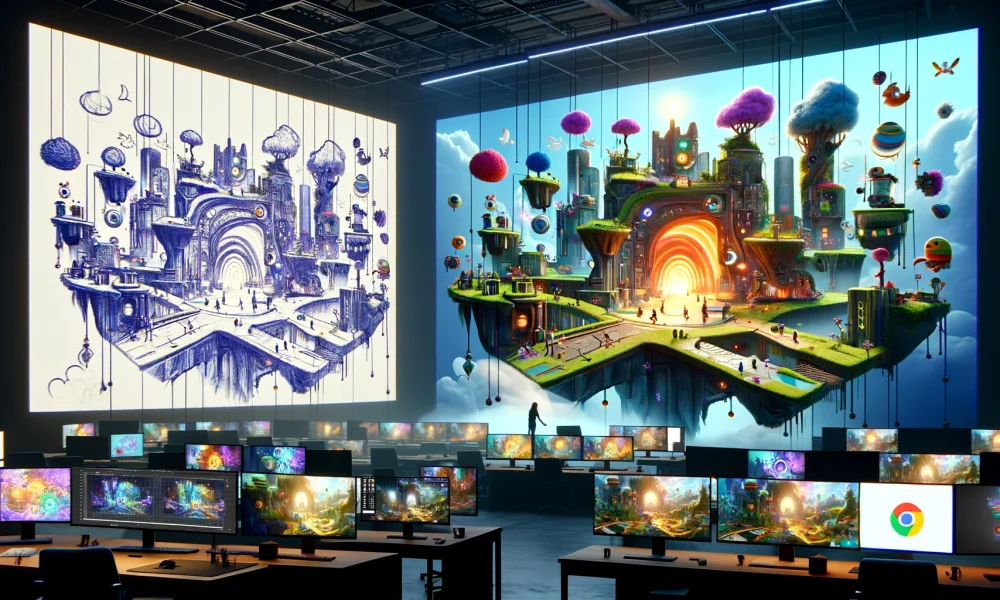The Rise of Video Games: Google’s Transformative Journey
The video game industry, now valued at $347 billion, has become a powerhouse in entertainment, captivating over three billion players worldwide. From classics like Pong and Space Invaders to modern marvels like Doom, the industry has continually pushed the boundaries of innovation. Today, Google is at the forefront of revolutionizing how video games are created, played, and experienced, leveraging its cutting-edge technology to redefine the gaming landscape.
Unleashing AI in Gaming: A Game-Changing Beginning
Google’s foray into AI gaming began with a groundbreaking development: creating an AI capable of learning and reacting like a human player. By introducing a deep reinforcement learning agent, Google unlocked the potential for AI to excel at complex video games based solely on visual input. This pivotal achievement paved the way for future breakthroughs in AI and machine learning.
AlphaStar: Mastering the Art of Strategy in StarCraft II
Building on their initial success, Google took on the challenge of conquering StarCraft II with AlphaStar, an AI agent that learned to play the game at a professional level through a combination of deep reinforcement and imitation learning. This accomplishment showcased AI’s ability to excel in intricate real-time strategy games, rivaling human performance.
AI Evolution: Transforming Gaming with Generalist AI
Google’s latest innovation, SIMA, marks a shift towards developing a versatile AI agent capable of navigating diverse game environments using natural language commands. This advancement signifies a new era of AI that can adapt and thrive across various gaming scenarios, revolutionizing how players interact with virtual worlds.
Empowering Game Design with Generative AI
Google’s focus has expanded to support game design through generative AI, enabling the creation of adaptive NPCs and procedural content generation. Tools like Genie empower users to design 2D video games effortlessly, bridging the gap between game development and creativity.
GameNGen: Revolutionizing Game Development through AI
Google’s GameNGen project aims to streamline the game development process by leveraging generative AI to create entire game worlds and narratives with just natural language prompts. This groundbreaking approach revolutionizes game development, offering a more efficient and accessible way to craft high-quality games.
The Future of Gaming: AI’s Impact on Video Games
Google’s advancements in AI are poised to reshape the gaming industry, ushering in a new era of creativity and efficiency in game development. As AI continues to evolve, developers will unlock new possibilities for innovative gameplay experiences, marking a significant milestone in the evolution of video games.
-
What is Google’s involvement in redefining video games with AI?
Google has been heavily involved in pushing the boundaries of video games with AI, particularly through projects like DeepMind, which has developed AI agents capable of mastering complex games like Go and StarCraft II. -
How does AI enhance the gaming experience for players?
AI in video games can enhance the gaming experience for players by providing more dynamic and challenging opponents, creating more realistic and immersive environments, and even helping to generate unique, personalized content for each player. -
How has Google’s work in AI impacted the gaming industry as a whole?
Google’s work in AI has had a significant impact on the gaming industry, sparking new innovations in game design, AI development, and player experiences. It has also raised important questions about the ethical implications of using AI in games. -
Will AI eventually replace human players in video games?
While AI has made remarkable advancements in gaming, it is unlikely to completely replace human players. Instead, AI is more likely to complement human players, providing new challenges and opportunities for gameplay. - What can we expect to see in the future of video games with AI?
In the future, we can expect to see even more sophisticated AI agents in video games, capable of adapting to player behavior, generating dynamic content on the fly, and perhaps even developing their own unique gaming experiences. This could revolutionize the way we play and interact with games in the years to come.



